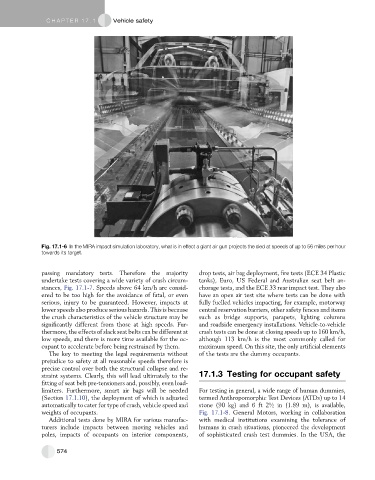Page 563 - Automotive Engineering Powertrain Chassis System and Vehicle Body
P. 563
CHAP TER 1 7. 1 Vehicle safety
Fig. 17.1-6 In the MIRA impact simulation laboratory, what is in effect a giant air gun projects the sled at speeds of up to 56 miles per hour
towards its target.
passing mandatory tests. Therefore the majority drop tests, air bag deployment, fire tests (ECE 34 Plastic
undertake tests covering a wide variety of crash circum- tanks), Euro, US Federal and Australian seat belt an-
stances, Fig. 17.1-7. Speeds above 64 km/h are consid- chorage tests, and the ECE 33 rear impact test. They also
ered to be too high for the avoidance of fatal, or even have an open air test site where tests can be done with
serious, injury to be guaranteed. However, impacts at fully fuelled vehicles impacting, for example, motorway
lower speeds also produce serious hazards. This is because central reservation barriers, other safety fences and items
the crush characteristics of the vehicle structure may be such as bridge supports, parapets, lighting columns
significantly different from those at high speeds. Fur- and roadside emergency installations. Vehicle-to-vehicle
thermore, the effects of slack seat belts can be different at crash tests can be done at closing speeds up to 160 km/h,
low speeds, and there is more time available for the oc- although 113 km/h is the most commonly called for
cupant to accelerate before being restrained by them. maximum speed. On this site, the only artificial elements
The key to meeting the legal requirements without of the tests are the dummy occupants.
prejudice to safety at all reasonable speeds therefore is
precise control over both the structural collapse and re-
straint systems. Clearly, this will lead ultimately to the 17.1.3 Testing for occupant safety
fitting of seat belt pre-tensioners and, possibly, even load-
limiters. Furthermore, smart air bags will be needed For testing in general, a wide range of human dummies,
(Section 17.1.10), the deployment of which is adjusted termed Anthropomorphic Test Devices (ATDs) up to 14
automatically to cater for type of crash, vehicle speed and stone (90 kg) and 6 ft 2½ in (1.89 m), is available,
weights of occupants. Fig. 17.1-8. General Motors, working in collaboration
Additional tests done by MIRA for various manufac- with medical institutions examining the tolerance of
turers include impacts between moving vehicles and humans in crash situations, pioneered the development
poles, impacts of occupants on interior components, of sophisticated crash test dummies. In the USA, the
574

